Dachstein-Mammuthöhle
Useful Information
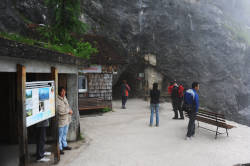
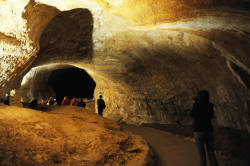
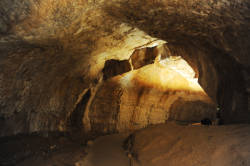
| Location: |
Obertraun, Salzkammergut.
A1 (E55) exit 234 Gmunden, follow B145 through Gmunden, Bad Ischgl, and Bad Goisern. Behind Bad Goisern turn right onto 166 to Gosaumühle, turn left along Hallstatt lake through Hallstadt to Obertraun. Take Dachstein Cable Car. 15 minutes walk (700 m, 40 m uphill) from Schönberg Alp, 1st station of the cable car. (47.534071, 13.709129) |
| Open: |
MAY to JUN daily 8:40-15:30. JUL to AUG daily 8:40-16:30. SEP to OCT daily 8:40-15:30. [2025] |
| Fee: |
Rieseneishöhle + Mammuthöhle + Cable Car: Adults EUR 48,70, Children (15-17) EUR 43,80, Children (6-14) EUR 26,80, Senior (65+) EUR 46,30. Groups (20+): Adults EUR 46,40, Children (15-17) EUR 40, Children (6-14) EUR 25. Trekkingtour ’Verfallene Burg’: Per Person EUR 113. Trekkingtour ’Große Mammuthöhle’: Per Person EUR 167. [2025] |
| Classification: |
 Karst Cave Karst Cave
|
| Light: |
 Incandescent Incandescent
|
| Dimension: | L=67,701 m, VR=1,207 m, A=1,368 m asl, T=3 °C. |
| Guided tours: |
Tourist tour: D=50 min, L=800 m, VR=80 m.





Trekkingtour ’Verfallene Burg’: D=4 h, Min=3, Max=15, MinAge=15. Trekkingtour ’Große Mammuthöhle’: D=1 day, Min=3, Max=10, MinAge=15. |
| Photography: | allowed |
| Accessibility: | no |
| Bibliography: |
Ing Hermann Bock et al. (1913): Höhlen im Dachstein und ihre Bedeutung für die Geologie, Karsthydrographie und die Theorien über die Entstehung des Eises Dem Andenken weiland Prof Friedrich Simonys. 151 pp some fine sepia photos, illus, maps etc. HB 
Günter Stummer (Red) (1980): Atlas der Dachstein-Mammuthöhle 1:1000. Wiss. Beihefte zur Zeitschrift "Die Höhle" Nr. 32. 
|
| Address: |
Dachstein Tourismus AG, Customer Service Team, Winkl 34, 4831 Obertraun am Hallstättersee, Tel: +43-50-140.
E-mail: |
| As far as we know this information was accurate when it was published (see years in brackets), but may have changed since then. Please check rates and details directly with the companies in question if you need more recent info. |
|
History
| 1910 | cave discovered. |
| 1911 | opened as a show cave. |
| 1973 | declared a Naturdenkmal (Natural Monument). |
| 2007 | start of renovation of all three caves by the Kunstuniversität Linz, Institut für Raum- und Designstrategie. |
| MAY-2008 | renovation completed. |
Description
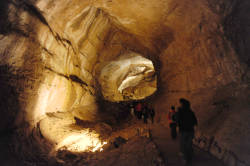
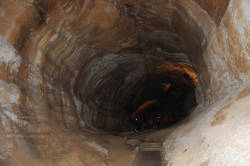
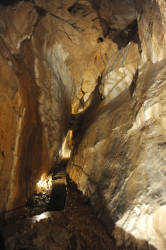
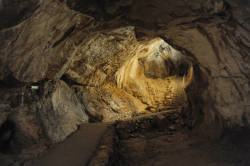
When the discoverers entered the Mammuthöhle (Mammoth Cave) for the first time, they were astonished by the huge passages. The cave is one of the biggest caves in the Dachstein Mountain. So they chose a name that would express the size of the cave, and they chose the Mammoth, the largest Pleistocene land animal in Europe. The huge size and the mostly horizontal passages made the development rather simple, and so the cave was opened to the public only a year later. Later an artificial entrance tunnel was built, the Neuer Osteingang (new eastern entrance), into the Lahnerhalle. The 800 m long tour through Halle der Vergessenen (Chamber of the Forgotten), a huge tunnel like passage named Paläotraun, to the Mitternachtsdom (Midnight Dome). The tour returns through a different passage named Arkadenkluft (Arcade Gap). Obviously the discoverers were quite creative when they named the cave.
The cave trekking tours in the Mammoth cave are quite interesting. The cave is rather big and mostly horizontal, and so they are suited for beginners, not much climbing and no crawling. One tour offers a trip into a labyrinth of passages with about one meter diameter which is really fun. Interesting is also a through tour to a second entrance on the other side of the mountain. This entrance is in the middle of the mountainside and much harder to reach on the surface than underground.
In the Dachstein district there are 200 caves of which Mammuthöhle is the largest. The size of the cave passages just have to be seen to be believed, on either side there are banks of mud with distinct layers which have been laid down by water. There are great dome shaped halls, with planes of repoussé, and giant keyhole shaped passages 20 m high and 12 m wide.
There are vertical grooves on the walls indicating running water, and there is red-brown staining from the iron mineral deposits. The only formations are the great white sponge deposits called Bergmilch which cover the walls.
The palaeolithic bed of the River Traun, long drained of water forms a gigantic tunnel and leads to the Mitternachtsdom (midnight dome), an enormous chamber over 40 m high which contains a multivisual slides show. It introduces visitors to the dangerous but exciting work of the speleologists (cave explorers).
Three rare species of beetle are found in this cave together with many cave bear bones. The cave is called Mammoth Cave, not because mammoth bones were found here, but because of its large dimensions.
Text by Tony Oldham (2002). With kind permission.
- See also
 Caves With a View
Caves With a View Search DuckDuckGo for "Dachstein Mammuthöhle"
Search DuckDuckGo for "Dachstein Mammuthöhle" Google Earth Placemark
Google Earth Placemark Dachstein-Mammuthöhle - Wikipedia
Dachstein-Mammuthöhle - Wikipedia  (visited: 01-AUG-2021)
(visited: 01-AUG-2021) Mammuthöhle - Höhlenlabyrinth der Superlative (visited: 01-AUG-2021)
Mammuthöhle - Höhlenlabyrinth der Superlative (visited: 01-AUG-2021) Georadar Survey for Detecting Ice Thickness (Project AUSTRO*ICE*CAVES*2100) (visited: 01-AUG-2021)
Georadar Survey for Detecting Ice Thickness (Project AUSTRO*ICE*CAVES*2100) (visited: 01-AUG-2021)
 Index
Index Hierarchical
Hierarchical Countries
Countries Maps
Maps